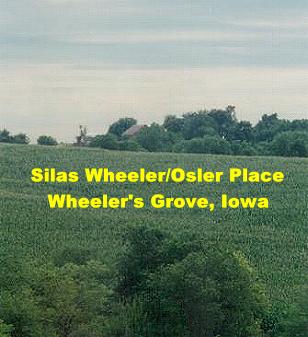|
Peg & Keith's Vacation trip to Iowa, July 1999 Segment E |
||
|
E. Drive across Iowa - Northeast to Southwest - Wheeler's Grove:
Next morning we were up early and, after a farewell breakfast at the cafeteria, on the road heading across the state of Iowa. The weather was still cooler. Gas was a noticeable $1.04 per gallon (in California it had been running $1.75). This time we followed AAA's advice and took the less scenic but more direct route. By early afternoon, we had entered the northeastern part of Pottawattamie County. We stopped first at a small museum in the dead little town of Oakland where a very elderly, charming lady tried to help us find material about the Wheelers and the Andersons who lived in Pottawattamie County in the 1800's. After much searching all we could find was a drawing of the fine home that our "rich uncle," Andrew Jackson Anderson, had in Carson, Iowa ,(circa 1880) after he had moved from Wheeler's Grove. We also found an article about a William J. Wheeler (born 1837) who doesn't appear to be related to our Wheelers.
We then drove south heading for the little town of Macedonia in hopes
that someone there could direct us to the Wheeler Grove Area. On the
way, Peg spotted a homemade sign pointing east to "Wheeler Grove
Church." We followed the sign for a couple of miles and came upon a
large grove of trees which we thought might be Wheeler's Grove. From a
rise in the road, we took a panoramic snapshot of the terrain. [See
photo album for Wheeler's Grove.] Going a
little further, on the edge of this grove, we found the Wheelers Grove
Church and across the road from it, the Wheelers Grove Cemetery. We
found the graves of the Wheeler brothers, after whom the grove was named
and members of their family. The brother's names were Solomon Modee
We kept hoping that someone might stop by who could tell us more about the area, but there was very little traffic on the road. We found to our surprise, that all along there had been someone parked in the back of the church out of sight from the cemetery and two ladies were in the basement meeting room. They welcomed us in, showed us around the church and gave us a booklet they had published to commemorate the Church's 125th anniversary in 1997. When asked if they knew anything about local history, one said that she knew very little, but knew who did. She promptly called a neighboring farmer, Norris Buckingham, who immediately drove over. Comparing notes, we soon discovered that we were fourth cousins. His farm, which lies just to the west of Wheeler's Grove, had been in the Buckingham family for over 120 years. His grandmother's name was Lenora Wheeler, daughter of Silas, one of the brothers. Norris, a very young looking 73 year old, was very friendly and helpful, giving us leads and contacts to further investigate our family connections in that part of Iowa. His mother's name was Osler and they were having a family reunion the very next weekend. We were invited, but could in no way attend. The Osler family is also briefly mentioned in the Slooper book, as they were also neighbors of the Andersons. Norris escorted us to the old Mormon Cemetery where we found the grave of our great grandmother Martha Anderson Wheeler Hilliard. He also showed us where the old Anderson ranch house once stood as well as the Silas Wheeler/Osler place on the east side of the grove.
We drove completely around the grove as skies were darkening both with storm and the lateness of the afternoon. We took pictures of the grove, the adjoining rich corn fields and Jordan Creek which meandered through the Grove and had recently flooded. While we are no experts on Midwest trees, one publication said that the original trees in the grove were principally black and white hickory, burr and red oak, black walnut, red and water elm, ash, hackberry and basswood. It was a handsome area and one could easily imagine the attraction to early farmers. We were relived to find that the grove was still intact and had not been bulldozed for agri-corn and soybeans. Norris had mentioned that many of the locals are hoping that the grove will someday become a State park.
It was now late in the afternoon, and realizing we had not had lunch, we headed west on country roads through the little village of Macedonia and on to Council Bluffs. There we found a convenient motel on the edge of the city, had an evening meal and went promptly to bed. A very enjoyable but full day!
|
||
|
Previous Segment Back to "Summer 1999 Trip to Iowa" Page Next Segment |
||
 Barber (S.M.B.) and Silas Wheeler. S.M.B. was mentioned in the Slooper
Book and apparently, they were both neighbors to the Jacob Anderson
family in the early 1850's. Our recent genealogical breakthrough
indicates that our great grandfather, Augustus Wheeler, was a first
cousin of these brothers.
Barber (S.M.B.) and Silas Wheeler. S.M.B. was mentioned in the Slooper
Book and apparently, they were both neighbors to the Jacob Anderson
family in the early 1850's. Our recent genealogical breakthrough
indicates that our great grandfather, Augustus Wheeler, was a first
cousin of these brothers.